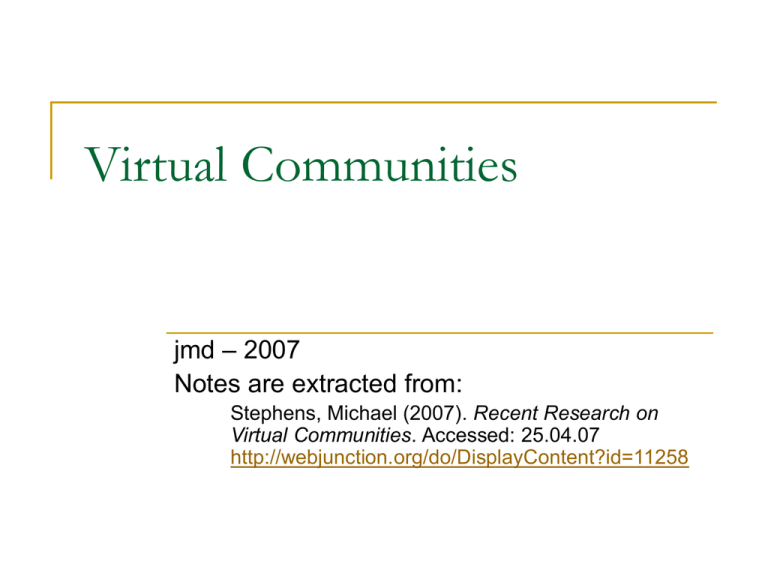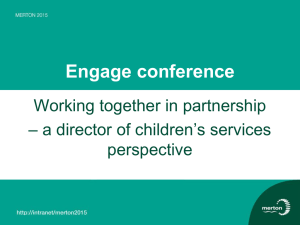Virtual Communities
advertisement

Virtual Communities jmd – 2007 Notes are extracted from: Stephens, Michael (2007). Recent Research on Virtual Communities. Accessed: 25.04.07 http://webjunction.org/do/DisplayContent?id=11258 Defining Virtual Community Howard Rheingold (1993): “Social aggregators that emerge from the Net when enough people carry on those public discussions long enough, with sufficient human feeling, to form webs of personal relationships in cyberspace.” (p. 5). Social Activity of VCs Goal of the community Methods of creating the group Evolution of the community Based on Wenger’s Social Learning Theory (1998) Henri & Pudelko’s 4 Types of VCs France Henri and Bétrice Pudelko (2003) presented a concise, useful typology for virtual communities, comprised of four distinct categories and descriptions of the exchanges that occur within them: Community of interest - Information exchange about a topic Goal-oriented community of interest - Sharing of diverse perspectives and production of objects commissioned by the mandate. Learner's community - Participation to the realization of a collective educational project. Community of practice - Professional practice development through sharing knowledge among members of a professional community Community of Interest Active Community of Interest Sites – many of these are goal oriented Coalfield Forum Wearabl e Tags NERAF West Forum SNCWD EBC South Forum YouthNet Facebook: http://www.studentaffairs.com/vcs/2006entries/BallStat eUniversity_wallaert_entry.ppt There are so many tools to support the building of virtual communities right now, and they all take time. It takes time to talk with people, and then when you do establish a larger network of contacts, these people in turn expect you to "keep in touch". Facebook can be attractive to those that want to establish a network quickly on a specific topic of interest. You can say it is based on the concept of Communities of Interest. CoI are formed by members from different background, that come together under a common goal or interest. The CoI can be loosely formed and temporary, and Facebook would support these types of communities. Learner’s Community NMC Campus in Second Life and supporting blog http://sl.nmc.org/ Second Life is a 3D platform that supports unnumbered virtual communities. Individual members have accounts and are represented by avatars (your virtual character) These characters can be members of groups, can send IM to members of the groups, can read the profiles provided by group members, can receive notices of group activities. Community of Practice The VC Debate: Are virtual communities really and truly communities? Baker & Ward (2002) When the excitement of a common tie wears off, users realize virtual communities “offer thin communion without additional geographic or physical linkages” (p. 221). The Internet Enhances Community “The virtual community does not include identification with place, but it does require common ties and social interaction.” (p. 375) Wired communities are informed A new communication tool However: narrow communication usually on a specific topic Driskell & Lyon 2002 Simultaneous & Ongoing: Driskell & Lyon’s Three Conclusions Participation in online interaction may: Reduce community Users’ time is devoted tosolitary searches and browsing. Create a weak replacement for community Users participate incommunities defined only by specific interests or topics Reinforce community Users find initial or supplemental connections that lead to community Information Behavior in Virtual Communities No Flaming No Spamming No Phishing Burnett (2002) Gary Burnett, a professor at the University of Florida, says, people who do not interact but just read posts are known as lurkers. Those invisible participants in the community, he states, read what others have written "without also writing themselves constitute significant information-gathering activities." The interactive behavior is more interesting. Two types of behavior: Hostile Positive or Interactive Hostile Interactive Behaviors Type Description Flaming Argumentative posts written purely for the sake of insulting others Trolling Posts seeking toillicit flames, called “flame-bait” by Tepper (1997) Spamming Posts regarded as unsolicited junk mail Cyber-rape Posts of an unsolicited, unwelcome and assaultive nature Positive Interactive Behavior Type Description Announcements Posts written to share information with members of the community Queries or Specific Requests for Posts requesting information, Information including: a) Queries made by other community members b) Queries taken out of the community c) Queries presented to the community Directed Group Projects Posts written to further a goal of the community, such as the creation of a FAQ (Frequently Asked Questions file), a database or project in the world outside the community Mynatt et al. (1998) Strong sense of “place” as newer tools for moving and communication emerge Identified 5 affordances (support) of the technologies that drive VCs Affordances of Virtual Communities Affordance Description Persistence Continuous over time and use by many Periodicity Sense of time and rhythm to interactions Boundaries Multi-use areas: rooms, forums, private areas Engagement Multiple ways to connect and interact Authoring Users create content and space, and recreate it as well Persistance Can be measured Ebb and flow of use Chats may be rapid Postings may be slower Periodicity VCs have a sense of time unique to each environment E-mail response time may be longer than a chat room Participants know these rhythms Boundaries VC space may have auditoriums, smaller forums and private rooms. Participants can move between them Information does not transfer between areas, must be carried Engagement Number of participants (1 to 1, many) Degree of participation Style of interaction Opportunity (scheduled, ad hoc) Authoring Participants create content and space Avatars and signature files Policies and norms are designed and created (FAQs) Future Research Wellman & Gulia’s Literature Review (1997) included interviews and personal experiences Anecdote should be replaced with evidence Offered 7 questions to study VCs 7 Questions to Define VCs 1. 2. 3. 4. 5. 6. 7. Are relationships on the Net narrow and specialized or broadly based? How does the Net affect people’s ability to sustain weaker, less intimate, relationships and to develop new ones? What is the nature of support on the Net? Are strong, intimate relationships possible online? How does high involvement in online communities affect participation in real world communities? What levels of diversity are there in online communities? Are virtual communities truly communities? Blogs & the Blosphere as VC Budding collaborative technologies such as blogs (Blanchard, 2004) and wikis (Ciffolilli, 2003), Web sites created by multiple authors in an encyclopedic format, offer new cyberspaces to apply and test theories. Blogs have many similarities to VCs Potential to evolve into beneficial, selfsustaining communities Lawley (2004) 5 approaches to studying blogs: study of the form itself study of interactions between blogs and blog authors ethnographic studies of blog clusters and communities analysis of the content and style used in Web logs study of the use of Web logs as tools in specific organizational contexts Wikis as VC Wiki:Collaborative Web site Ciffolilli (2003) examined retention of members for the wikipedia Determined wikis can succeed as sustainable communities with a good balance of member interaction and policy Smart Mobs Rheingold (2002) book Smart Mobs, ponders where new technologies will take us. Smart mobs, a recent off-shoot of interaction online, are planned events created by those "who are able to act in concert even if they don't know each other" (p. xii) by using networked devices such as cell phones, PDAs and laptops and Internet. References Baker, P. M. A., & Ward, A. C. (2002). Bridging temporal and spatial gaps: the role of information and communication technologies in defining communities. Information, Communication & Society, 5(2), 207-224. Blanchard, A. (2004). Blogs as Virtual Communities: Identifying a Sense of Community in the Julie/Julia Project. Retrieved October 1, 2004, from http://blog.lib.umn.edu/blogosphere/blogs_as_virtual.html Burnett, G. (2000). Information exchange in virtual communities: a typology. Retrieved August 31, 2004, 2004, from http://informationr.net/ir/5-4/paper82.html Burnett, G. (2002). The Scattered members of an invisible republic: virtual communities and Paul Ricoeur’s Hermeneutics. The Library Quarterly, 72(2), 155-178. References Burnett, G., Dickey, M. H., Kazmer, M., & Chudoba, K. (2003). Inscription and interpretation of text: a cultural hermeneutic examination of virtual community. Retrieved September 21, 2004, from http://InformationR.net/ir/9-1/paper162.html Ciffolilli, A. (2003). Phantom authority, self-selective recruitment and retention of Members in virtual communities: the case of wikipedia. Retrieved September 21, 2004, from http://firstmonday.org/issues/issue8_12/ciffolilli/index.html Driskell, R. B., & Lyon, L. (2002). Are virtual communities true communities? Examining the environments and elements of community. City & Community, 1(4), 373-390. Henri, F., & Pudelko, B. (2003). Understanding and analysing activity and learning in virtual communities. Journal of Computer Assisted Learning (19), 474-487. References Lawley, E. (2004). Blog research issues. Retrieved September 28, 2004, from http://www.corante.com/many/archives/2004/06/24/blog_research_iss ues.php Long, B., & Baecker, R. (1997). A Taxonomy of Internet Connection Tools. Paper presented at the WebNet '97, Toronto, Ontario, Canada. Mynatt, E., O'Day, V., Adler, A., & Ito, M. (1998). Networked communities: Something old, something new, something borrowed... Computer Supported Cooperative Work: The Journal of Collaborative Computing (7), 123-156. References Rheingold, H. (1993). The Virtual Community: Homesteading on the Electronic Frontier. New York: HarperPerennial. Rheingold, H. (2002). Smart Mobs The Next Social Revolution. Cambridge: Perseus Publishing. Stephens, Michael (2007). Recent Research on Virtual Communities. http://webjunction.org/do/DisplayContent?id=11258 Wellman, B., & Gulia, M. (1999). Net surfers don't ride alone: Virtual communities as communities. Retrieved September 24, 2004, from http://www.chass.utoronto.ca/~wellman/publications/netsurfers/netsurfers.pdf






